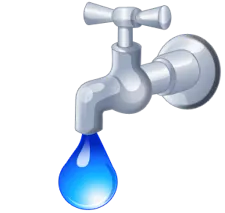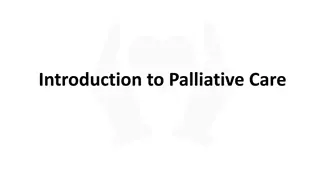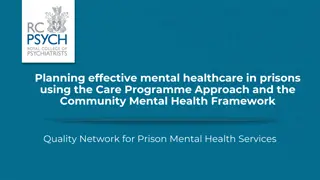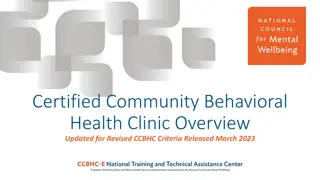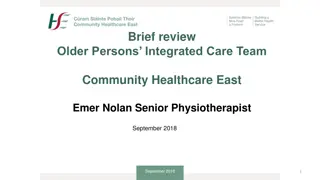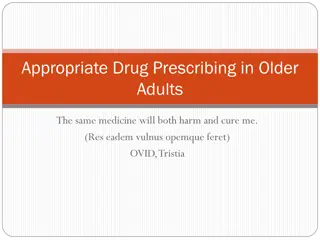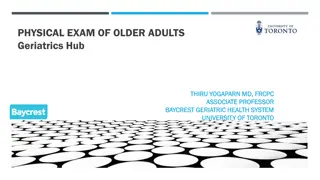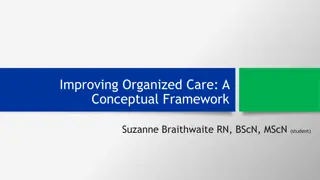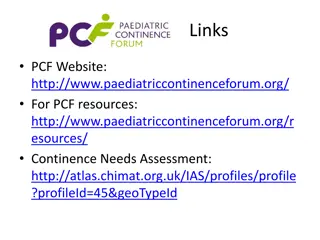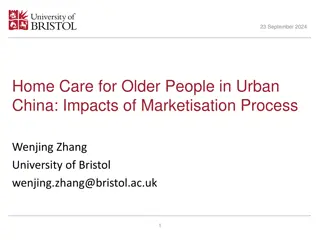Continence Care in the Community
Continence care in the community focuses on maintaining normal bladder and bowel functions to support individuals in managing their toileting needs effectively. Continence involves being aware of bodily signals, knowing when and how to void or defecate, managing clothing, storing urine or bowel movements until appropriate, and practicing proper hygiene. Incontinence, on the other hand, refers to the loss of control of bladder or bowel functions, which can impact individuals of all ages. The extent of continence issues in Australia highlights the importance of proper education, support, and resources to address this common concern.
Download Presentation

Please find below an Image/Link to download the presentation.
The content on the website is provided AS IS for your information and personal use only. It may not be sold, licensed, or shared on other websites without obtaining consent from the author.If you encounter any issues during the download, it is possible that the publisher has removed the file from their server.
You are allowed to download the files provided on this website for personal or commercial use, subject to the condition that they are used lawfully. All files are the property of their respective owners.
The content on the website is provided AS IS for your information and personal use only. It may not be sold, licensed, or shared on other websites without obtaining consent from the author.
E N D
Presentation Transcript
Grampians Region HACC Program Continence Care in the Community for Community Support Workers November 2014
Grampians Region HACC Program - Continence Care in the Community What is Continence? The Normal Bladder o Dryness at all times o Voiding 4-6 times per day & 0-1 times at night o Passing 250-400 mls of urine per void o Ability to defer as long as required to get to the toilet o Passing a continuous stream of urine without burning or pain o Sense of complete emptying once finished The Normal Bowel o Bowel action between 3 times per day to 3 times per week o Soft, formed stool o Passage of stool without straining o Have sensation of rectal fullness and warning prior to passage
Grampians Region HACC Program - Continence Care in the Community Continence is complex . To be continent you need to be able to: o Be aware of an urge to void/defecate o Know what to do and where to go o Be able to get there & manage your clothing o Store urine/bowel motion until the right time o Empty bladder/bowel on cue o Manage wiping/drying/clothing
Grampians Region HACC Program - Continence Care in the Community Pelvis and bladder with pelvic floor muscles
Grampians Region HACC Program - Continence Care in the Community Incontinence is .. Loss of control of the bladder or bowel that is involuntary and socially unacceptable It is a symptom .. not a disease It is something that affects all ages
Grampians Region HACC Program - Continence Care in the Community The extent of the problem o Up to 4.8 million Australians o 1 in 4 women o 1 in 10 men o People of all ages not just the elderly or disabled o 15 22% of hospitalized patients o Over 50% of the elderly in residential care o Significant costs to community, acute and residential care facilities o 2008/09 - $201.6 million spent in Australia
Grampians Region HACC Program - Continence Care in the Community The myths about Incontinence o A normal part of ageing o Expected with childbearing o There is nothing that can be done o I am the only one o Children will grow out of wetting o It is not a serious problem
Grampians Region HACC Program - Continence Care in the Community But there can be age related changes: o Altered urine production o Hormonal changes o Decrease in strength of pelvic floor muscles o Prostatic hypertrophy (Enlarged Prostate) o Neurological changes o Mobility and dexterity o Medical conditions o Current medications
Grampians Region HACC Program - Continence Care in the Community Types of Urinary Incontinence There are different types of urinary incontinence therefore: o We need to identify the cause of the symptoms o Different types of incontinence require different treatments o We need to collect information so the correct type of management plan can be put in place
Grampians Region HACC Program - Continence Care in the Community Types of Urinary Incontinence oStress Incontinence oUrge Incontinence oOverflow Incontinence oFunctional Incontinence
Grampians Region HACC Program - Continence Care in the Community Types of Urinary Incontinence Stress Incontinence Involuntary loss of a small amount of urine, when coughing, sneezing, laughing or on change of position o Weakened sphincters & pelvic floor muscles o Excessive intra-abdominal pressure o Difficulty stopping urine flow mid stream
Grampians Region HACC Program - Continence Care in the Community Types of Urinary Incontinence Stress Incontinence - Causes o Weakened Pelvic Floor Muscles Childbirth (Trauma) Persistent Heavy Lifting Obesity Chronic Cough Straining to pass a stool o Fall in oestrogen levels may cause a weakness in pelvic floor muscles o Congenital weak sphincter mechanism o Sphincter damage post surgery
Grampians Region HACC Program - Continence Care in the Community Types of Urinary Incontinence Urge Incontinence Involuntary loss of urine associated with a strong desire to void Often comes with little warning Usually as the result of an over contraction of the bladder muscle
Grampians Region HACC Program - Continence Care in the Community Types of Urinary Incontinence Urge Incontinence o Over Active Bladder o Unable to hang on o Urgency o Large Volume of urine o Frequency
Grampians Region HACC Program - Continence Care in the Community Types of Urinary Incontinence Urge Incontinence - Causes o Urinary Tract Infection o Cystitis / Calculi / Tumours o Constipation o Caffeine / Food Additives o Medications (Diuretics) o Anxiety o Neurological Disorders (CVA, Multiple Sclerosis, Parkinson s Disease)
Grampians Region HACC Program - Continence Care in the Community Types of Urinary Incontinence Overflow Incontinence Inability to pass urine so it builds up and overflows o Blockage of bladder outlet / obstruction Enlarged prostate, strictures, sphincters not relaxing on cue Faecal Impaction o Bladder Muscle not contracting sufficiently
Grampians Region HACC Program - Continence Care in the Community Types of Urinary Incontinence Overflow Incontinence symptoms o Constant leakage or dribbling o Post void dribble o Difficulty starting flow / hesitancy o Poor stream / interrupted o Feeling of incomplete bladder emptying o Frequency small urinary volumes o UTI Urinary Tract Infection o Distended abdomen: painful or painless Confirmed with a portable bladder scan
Grampians Region HACC Program - Continence Care in the Community Types of Urinary Incontinence Functional Incontinence The sensation to void is present but the person is unable to reach the toilet in time
Grampians Region HACC Program - Continence Care in the Community Types of Urinary Incontinence Functional Incontinence Causes o Impaired mobility o Impaired dexterity Unable to remove clothing o Cognitive impairment o Environmental Reasons: Location of toilets Availability of toilets Chair or Toilet Height
Grampians Region HACC Program - Continence Care in the Community Maintaining Bowel Control Requires several factors: o Effective barrier to outflow provided by the internal and external sphincters o A normal rectum that stretches and can hold a good volume of stool and then is able to contract to empty o Intact anal sensation o Bulky and firm stools (but not hard)
Grampians Region HACC Program - Continence Care in the Community Faecal Incontinence Loss of control of the bowel in an inappropriate time and place May be leakage of gas, liquid or solid stool
Grampians Region HACC Program - Continence Care in the Community Constipation The infrequent passage of bowel motions The stool may be hard or lumpy, the person may need to strain to pass the stool, they may have a feeling of incomplete evacuation and may pass less than 3 bowel motions a week o It is more common in women than men, especially younger (20ish) and older women o 26% of men & 34% of women over 65 years report constipation o 30 50% of elderly people regularly use laxatives Constipation has been shown to decrease quality of life and well being.
Grampians Region HACC Program - Continence Care in the Community Common conditions associated with Constipation in the elderly o Immobility o Dehydration and/or inadequate Diet o Neurological Causes Spinal Cord, MS, Parkinsons Disease o Gut lesions Obstructions Carcinoma s Post Surgery Abnormalities Haemorrhoids o Intestinal Conditions ie. Diverticular Disease o Cognitive Impairment o Medications
Grampians Region HACC Program - Continence Care in the Community Why is Continence Important? It has significant impacts on: o An individual s dignity, self-esteem and wellbeing o Health Dehydration and inadequate diet, skin integrity, poor sleep o Personal & Intimate Relationships o Social Interactions Afraid to socialise and go out of the home o Income Cost of Continence Aids, can reduce spending on other activities o Household Tasks Increased Washing o Future May be a significant contributing factor in the decision to admit to residential aged care
Grampians Region HACC Program - Continence Care in the Community Signs that a client may be incontinent o Smell (odour) when entering the home or when assisting a client o Poor Skin Integrity or discomfort while assisting to wash o Soiled clothing or often client stays in their night wear o Wet Bed or bed already stripped when you arrive o Increased changing & washing of clothes and bed linen o Wet spots on furniture o Not wanting to leave the home for shopping, appointments or for social occasions o Not drinking or eating much (or Client may be ill) o Not taking Diuretic Medication o Cancelling visits of support staff at the last minute o Not as chatty and outgoing as previously o Always tired and complaining of lack of sleep
Grampians Region HACC Program - Continence Care in the Community What should I do if I think there is an incontinence problem? o Many people with a continence problem do not seek help because of embarrassment, shame or they think that nothing can be done o If you have a comfortable relationship with the client, talk with the client about what is bothering them or the changes that you have observed Use a gentle, calm tone of voice Choose simple words & short sentences Actively listen to the client, be careful not to interrupt Offer reassurance that the problem can be assessed and a possible treatment or management can be found
Grampians Region HACC Program - Continence Care in the Community What should I do if I think there is an incontinence problem? Document: Community Support Worker Process Guide o Report your concerns to your supervisor o Complete written documentation (Screening Tool, Memo or Request for Review form) clearly explaining why you have these concerns or what you may have observed o If you have spoken to the client about your observations, report their responses o The Assessment Officer will follow up with the client and if a problem is identified, will discuss with the client possible referral and support
Grampians Region HACC Program - Continence Care in the Community Referral Pathways Document: Referral Pathways The Assessment Officer o Referral & Support Clients may already be attending a Continence Clinic or consulting their GP in regard to Continence problems The client may choose to consult their GP The client may decide to self refer to a Continence Nurse/Clinic The client may prefer for the Assessment Officer to make a referral to an appropriate provider on their behalf o Provision of contact details or information on how to access continence aids for short time use
Grampians Region HACC Program - Continence Care in the Community What services may be able to assist the client or their carer? o General Medical Practitioners o Continence Nurses & Continence Clinic o Specialist Physiotherapists o Occupational Therapists Home Modifications o Memory & retraining specialists o Financial Assistance for the cost of Continence Products (if eligible) o Continence Foundation of Australia o Carers Support
Grampians Region HACC Program - Continence Care in the Community How can I assist my client with their Continence Management Plan? o If your client requires ongoing continence support to be provided by the Community Support Worker the Continence Service will complete a Service Handover Plan Personal Care Tasks tool o For some tasks Client Specific Training will need to be undertaken with the Continence Service Document: Role of the Community Support Worker
Grampians Region HACC Program - Continence Care in the Community Continence Products o The Continence provider will advise on the best products for each individual taking into account: What type of incontinence and the amount of urine/faeces accidently lost The gender of the person The size and shape of the person Who is available to assist the client to change products (if needed) What can be afforded How active the person is / social needs
Grampians Region HACC Program - Continence Care in the Community Types of Continence Products o Disposable and reusable pads o Disposable and reusable pants o Urinals, Bed Pans and Commodes o Condom drainage o Catheters Intermittent, Indwelling & Supra-pubic o Leg Bag and Night Bag or Bottle o Flip Flow Valve o Chair protection o Bed protection
Grampians Region HACC Program - Continence Care in the Community Fluid or Bowel Charts o As a Community Support Worker you may be asked to assist a client to keep a Fluid Chart or a Bowel Chart o A Bowel Chart collects the following: Timing of Bowel Motions Stool Consistency and Size (Next slide) Any Incontinence when, what, how much, warning or awareness Observation of straining, pain, mucous, blood .. Record anything taken for the bowels
Grampians Region HACC Program - Continence Care in the Community Fluid or Bowel Charts
Grampians Region HACC Program - Continence Care in the Community Prevention does help .. o Drink Well 1.5 2 litres of fluid per day o Eat a Healthy Diet o Lead a Positive Lifestyle Ideal Body Weight & Stop Smoking o Get Active 30 minutes a day o Practice Good Toilet Habits o Correct sitting position on the toilet (next slide) o Get help if you experience bladder or bowel control problems
Grampians Region HACC Program - Continence Care in the Community Prevention does help ..
Grampians Region HACC Program - Continence Care in the Community Resources & Further Information o Websites o Continence Foundation of Australia www.continence.org.au o Further Training o e3Learning o Other Courses
Grampians Region HACC Program - Continence Care in the Community Questions????
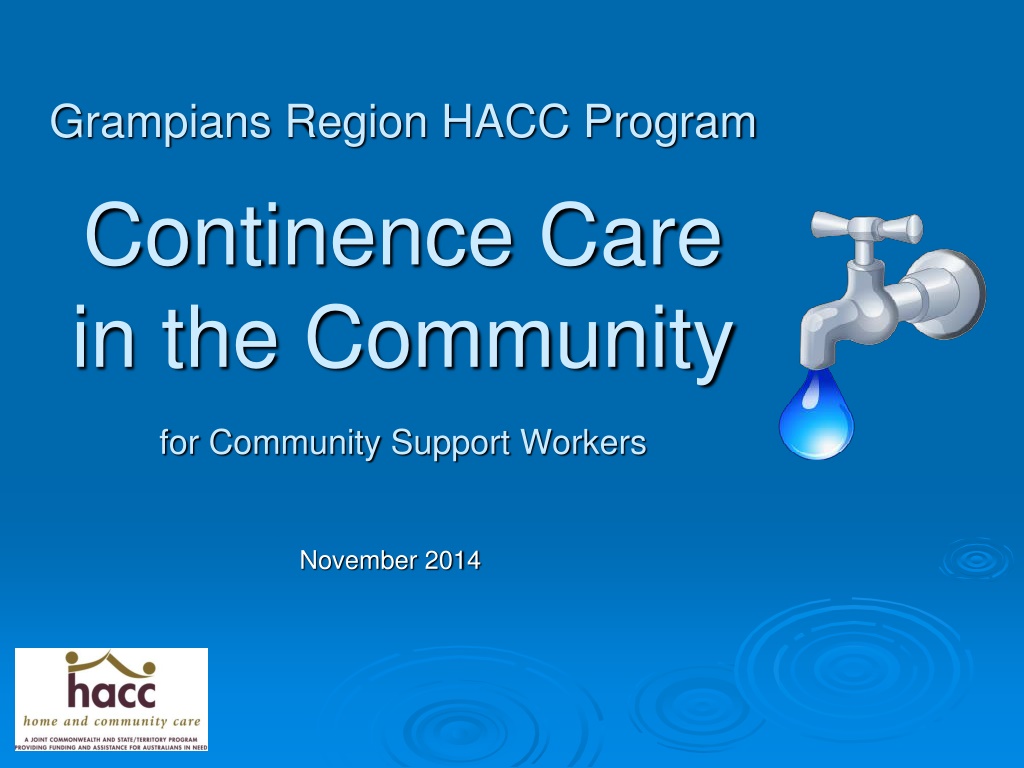
 undefined
undefined
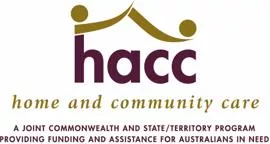
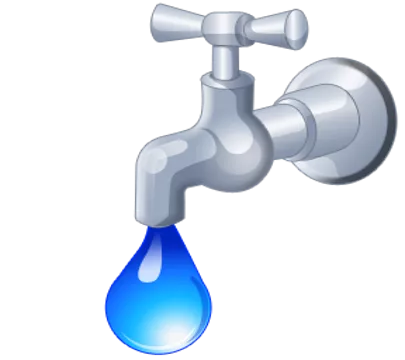
 undefined
undefined